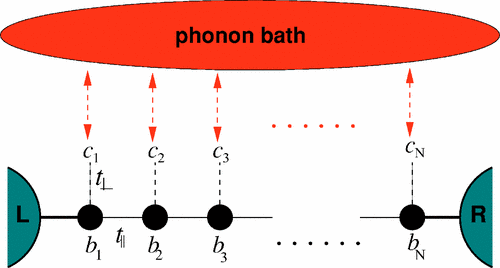We investigate the influence of a dissipative environment which effectively comprises the effects of counterions and hydration shells, on the transport properties of short DNA wires. Their electronic structure is captured by a tight-binding model which is embedded in a bath consisting of a collection of harmonic oscillators. Without coupling to the bath a temperature independent gap in the electronic spectrum opens in the electronic spectrum. Upon allowing for electron-bath interaction the gap becomes temperature dependent. It increases with temperature in the weak-coupling limit to the bath degrees of freedom. In the strong-coupling regime a bath-induced pseudo-gapis formed. As a result, a crossover from semiconducting to metallic behavior in the low-voltage region of the I-Vcharacteristics is observed with increasing temperature. The temperature dependence of the transmission near the Fermi energy, t(EF), manifests an Arrhenius-like behavior in agreement with recent transport experiments. Moreover, t(EF) shows a weak exponential dependence on the wire length, typical of strong incoherent transport. Disorder e ects smear the electronic bands, but do not appreciably affect the pseudo-gap formation.

We investigate the influence of a dissipative environment which effectively comprises the effects of counterions and hydration shells, on the transport properties of short DNA wires. Their electronic structure is captured by a tight-binding model which is embedded in a bath consisting of a collection of harmonic oscillators. Without coupling to the bath a temperature independent gap in the electronic spectrum opens in the electronic spectrum. Upon allowing for electron-bath interaction the gap becomes temperature dependent. It increases with temperature in the weak-coupling limit to the bath degrees of freedom. In the strong-coupling regime a bath-induced pseudo-gapis formed. As a result, a crossover from semiconducting to metallic behavior in the low-voltage region of the I-Vcharacteristics is observed with increasing temperature. The temperature dependence of the transmission near the Fermi energy, t(EF), manifests an Arrhenius-like behavior in agreement with recent transport experiments. Moreover, t(EF) shows a weak exponential dependence on the wire length, typical of strong incoherent transport. Disorder e ects smear the electronic bands, but do not appreciably affect the pseudo-gap formation.
